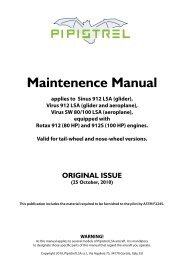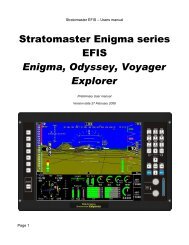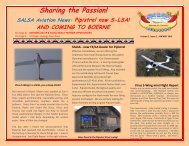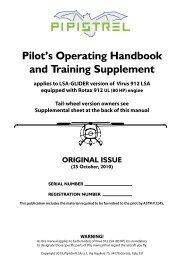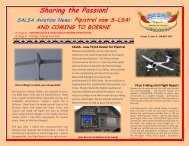Pipistrel Virus Aircraft Operating Instruction - Salsa Aviation
Pipistrel Virus Aircraft Operating Instruction - Salsa Aviation
Pipistrel Virus Aircraft Operating Instruction - Salsa Aviation
Create successful ePaper yourself
Turn your PDF publications into a flip-book with our unique Google optimized e-Paper software.
AIRCRAFT OPERATING INSTRUCTIONS – VIRUS 912 S-LSA GLIDER7.6.8 Deployment of GRS rescue system.System descriptionThe GRS rocket charged parachute rescue system provides you with a chanceto rescue yourself from an unexpected situation. The system is placed inside adurable cylinder mounted on the right hand side of the baggagecompartment. Inside this cylinder is the parachute which stored inside adeployment bag with a rocket engine underneath. This brand new designdeploys a canopy that is not gradually drawn from the container, exposed todistortion by air currents, but it is safely open after 0,4 to 0,7 seconds indistance of 15-18 meters above the aircraft. It is carried there in a specialdeployment bag, which decreases the risk of aircraft debris fouling thecanopy. The parachute rescue system is activated manually, by pulling theactivation handle mounted on the back wall above. After being fired, the mancanopy is open and fully inflated in about 3.2 seconds.WARNING! Activation handle safety pin should be inserted when the aircraft is parked orhangared to prevent accidental deployment. However, the instant pilot boards the aircraft,safety pin MUST be removed!Use of parachute rescue systemTypical situations for use of the parachute rescue system are:structural failuremid-air collisionloss of control over aircraftengine failure over hostile terrainpilot incapacitation (incl. heart attack, stroke, temp. blindness, disorientation...)Prior to firing the system, provided time allows:1. shut down the engine and set master switch to OFF (key in full left position)2. shut both fuel valves3. fasten safety harnesses tightly4. protect your face and body.To deploy the parachute jerk the activation handle hard to a length of at least 1 foottowards the instrument panel.Once you have pulled the handle and the rocket is deployed, it will be about two secondsbefore you feel the impact produced by two forces. The first force is produced by astretching of the system risers. The second force follows from the inflation of thecanopy. It will seem to you that the aircraft is pulled backwards briefly. The airspeed isreduced to zero, and the aircraft now starts to descend underneath the canopy.As the pilot, this is likely a new experience, and you should know that the phase followingparachute deployment will be a great adventure for the crew. You will be in a situationfor the first time, where a proper landing and the determination of the landing site areout of your control.Page 20



